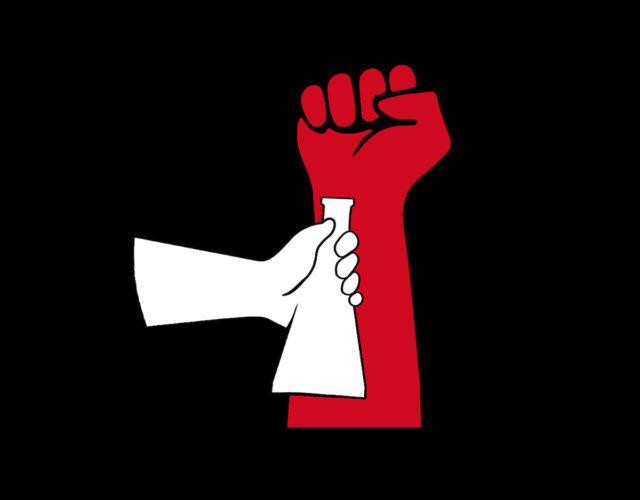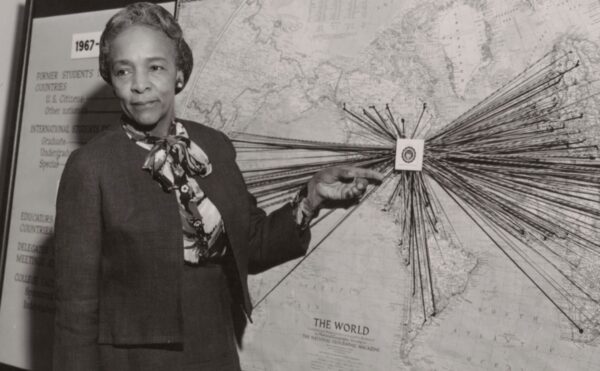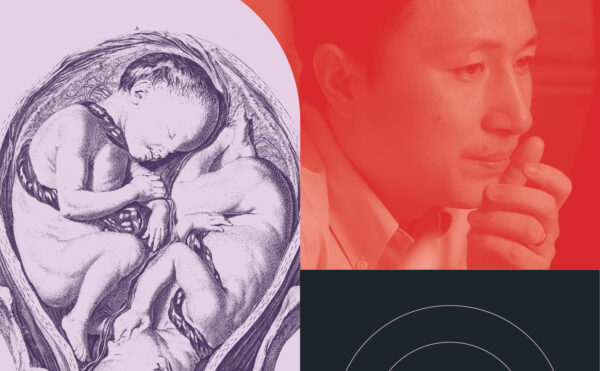On April 22, 2017, more than one million people in 600 cities around the world took to the streets in the name of science. Many were scientists themselves, and quite a few donned lab coats. Some were protesting for the first time. It was an unusual sight, perhaps, but science has never been immune to politics.
“If we could imagine angels doing science, maybe it wouldn’t be political,” says Liz Lopatto, science editor of the technology site The Verge, “But since it’s humans, it’s inescapable.”
Throughout the past century, quite a few scientists have taken up political causes, but the tide of politics and science ebbs and flows from the labs to the streets and back again. Now, after a period of relative quiet, it seems to be flowing again. But this time, it’s different. Sociologist Kelly Moore says, “I don’t know of any period in American history when scientists have felt the need to collectively defend science as a public good.”
Credits
Hosts: Michal Meyer and Bob Kenworthy
Producer: Mariel Carr
Associate Producer: Rigoberto Hernandez
Additional Reporting and Production: Kyrie Greenberg
Audio Engineer: Dan Powell
Original music composed by Zach Young
Additional music courtesy of the Audio Network
Transcript
Crowd Chanting >> Science not silence! Science not silence! Science not silence!
Michal: Hello and welcome to Distillations, the science, culture, and history podcast. I’m Michal Meyer, a historian of science and editor in chief of Distillations magazine, here at the Chemical Heritage Foundation.
Carol Tenneriello >> Like the point of this march is to say like, if it’s raining outside it doesn’t matter if I believe in water or not, I’m still gonna get wet.
Bob: And I’m Bob Kenworthy, CHF’s in-house chemist. That was Carol Tenneriello. She’s a nurse and a lactation consultant who joined thousands of other protestors at the Philadelphia March for Science on Earth Day, 2017.
Rigo >> Is this what scientists look like?
Woman on the street>> This is absolutely what scientists look like.
Michal: And that’s Rigo Hernadez our associate producer. He marched with the crowds and met a lot of people who believe in science, and worry that it’s under threat.
Science March >> Hey hey ho ho alternative facts have got to go—
Man on the street >> A year ago the brain initiative was big news and it seemed like a really really good time to be in neuroscience specifically. And it seems like with the changes in administration that we have to fight a lot harder for that to stay the same.
Music Science March >>
Man on the street >> As a licensed engineer our work is for the public. My sign is about applying science in a common sense way so that we can continue to maintain our infrastructure and frankly so it doesn’t become inundated with sea level rise and global warming.
Bob: An estimated one million people took to the streets in more than 600 cities throughout the world on April 22nd to speak out for science. Lots of them wore lab coats. And many had never been to a protest before.
Michal: And it got us thinking. scientists and lab coats are not a typical sight at a protest because science isn’t usually political, right? Or is it?
Liz Lopatto >> There is probably a theoretical world, maybe? I don’t know. If we could imagine angels doing science, maybe it wouldn’t be political but since it’s humans doing science, it’s inescapable. You know what I mean? It’s a human endeavor.
Michal: That’s Liz Lopatto. She’s the science editor for the technology site the Verge. She was on vacation on November 8th, 2016.
Liz Lopatto >> And I came back in the next day because it was obvious there were going to be stories for us about what the Trump administration was going to mean for the sciences, particularly because he had seemed to be so dismissive of scientific expertise during the election. So we went and wrote them and we started getting these emails from our readers like, “Why is there politics in my science section?”
People had gotten used to thinking of science as being this little castle, right? Or all of the normal human concerns don’t really appear in the same way and it’s very clean and precise and you don’t have to worry in the same way about the messiness of the humans who conduct it as you do in other things and that’s wrong.
Roger Eardley-Pryor >> Is science political? The answer is yes, but where people get mixed up is, I think, thinking two different ways about science.
Bob: CHF research fellow Roger Eardley-Pryor. He’s a historian of American science politics and the environment.
Roger Eardley-Pryor >> Science is both a noun and a verb, it can be both. And science as a verb is a process, an ever growing process. We no longer think of the earth as the center of the universe as the earth revolving around the sun. And science as a process is done by humans.
Anything done by humans is going to be political because it involves relations of power.
Bob: Both Liz and Roger talk about how politics infiltrates the act of doing science at so many points: from deciding which scientific research gets funded, to what any given scientist chooses to study.
Michal: Liz Lopatto says that its’ not just the results of science its that even the scientific process itself and therefore the knowledge it leads to.
Liz Lopatto >> I wouldn’t say empiricism is necessarily political, although it certainly feels so right now. It is, nonetheless, an ideology, right? And there are other ideologies out there, which don’t believe that, right? It’s a little bit worrying if you are an empiricist, if you are a person who says, “Yes. Our observed, shared world is the real world and we can know facts about it and this is how we do it.” It’s a little bit disconcerting to see someone who doesn’t seem to have … How would I put this? Doesn’t seem to have a functioning relationship with facts.
Michal: It was an unexpected sight. Hoards of scientists in lab coats marching in the street. But perhaps it shouldn’t have been. It turns out that quite a few American scientists have gotten political over the decades. Albert Einstein and Linus Pauling rallied against nuclear weapons. Biologist Barry Commoner even ran for president in 1980.
Bob: the tide of science and politics waxes and wanes. Into the streets and back into the labs. and after a period of relative quiet it seems to be waxing again.
Newsreel >> The tremendous crowds which you see gathered outside the stock exchange are due to the greatest crash in the history of the NY stock exchange.
Peter Kuznick >> Scientists had become politicized for the first time really in the progressive sense in the 1930s.
Michal: That’s Peter Kuznick. He’s a history professor and the director of the Nuclear Studies Institute at American University. We asked Peter where he’d mark the start of our politically active American scientists timeline and he pointed to the 1930s.
Peter Kuznick >> The scientists began the decade being criticized for being so conservative. They become politicized over the course of the decade. And by the end of the decade the scientists are overwhelmingly on the left.
Bob: In the 1920s the economy was booming and science was fueled by industry and private foundations. But then the depression hit in 1929 and people blamed technology and scientists, thinking:
Peter Kuznick >> That the scientists were untrustworthy because they allowed their discoveries or their technology to be used to replace people on the job.
Michal: That wasn’t entirely true but it did bring up a valuable point.
Kuznick >> I often cite a comment buy a sociologist, Reed Bain which he says: “the scientists are the worst citizens of the republic. They take no responsibility for anything, no responsibility for the uses of their own discoveries and inventions.”
Michal: This theme would come back to haunt American scientists after World War 2. But before we get there, by the end of the 1930s, scientists create something called the science and Society Movement and they start talking about their “special, unique social responsibility.” They had become anti- fascist, and a lot of them are intrigued by socialism and communism.
Peter Kuznick >> By the end of the decade the scientists are universally on the left. It’s a remarkable transformation.
Roger Eardley-Pryor >> The atomic bomb, the thunder clap of the atom on the planet, the power of the sun unleashed in the deserts over New Mexico and destroying cities across Japan, that was a radical change in understanding the power of science and the way that it’s used in a political realm.
Bob: WWII changed everything, including science.
Newsreel >> America goes to war
Michal: Doing WWII the US government invested in science in ways that it never had before. And not just to make the atom bomb. Scientists were called on to fight racism and help win the war.
Roger Eardley-Pryor >> It just felt like, at the time, the world order was threatened. Democracy itself, capitalism itself, felt under threat, and in order to protect the values of civilization in a lot of these scientist’s mind, including being able to do science freely, they felt like they had to become partners with the state and do a lot of this research for World War II.
Michal: Thousands of scientists went to work on the Manhattan project. The U.S. government successful attempt to build the worlds first nuclear weapons. In August 1945- two atomic bombs were dropped on the Japanese cities of Hiroshima and Nagasaki –ushering in the nuclear age. The perception back home was that scientists had helped win the war. Scientists were hailed as miracle workers, but in its aftermath-many scientists began to question the power they had unleashed.
J. Robert Oppenheimer clip >> I remember the line from the Hindu scripture, the Baghavadh Gita: Now I have become death, the destroyer of worlds. I suppose we all thought that.
Roger Eardley-Pryor >> J. Robert Oppenheimer was the father of the American bomb. He was the American Prometheus. He came and took the fire of the sun and brought it to the earth. He helped build the nuclear bomb. He was respected as an advisor for even political decision, policy decisions about how to use the bomb.
Bob: But after the war Oppenheimer became ambivalent about nuclear weapons. In 1945 he told President Truman that he had blood on his hands. And in 1946 he gave a famous speech at the American Philosophical Society in Philadelphia.
Oppenheimer >> We have made a thing. A most terrible weapon. We have made a thing that by all the standards of the world we grew up in, is an evil thing.
Bob: Many of the nuclear scientists who helped make these weapons were concerned about nuclear proliferation.
Oppenheimer >> For months now there’s been among scientists, as well as many others, a concern. It seems to me that these reactions among scientists, that have caused them to meet and speak and testify and write and wrangle without remission, reflect, correctly reflect an awareness of unparalleled crisis.
Michal: They created the atomic scientists movement. The idea was pretty simple, they understood how to build the bombs, and the threats they posed. So they were the ones best equipped to make policy recommendations on how to control the bombs. Some scientists just wanted to regulate their use, others called for their outright ban.
Peter Kuznick >> They understood the power of nuclear weapons. They also at a very early time realized that nuclear war might not only mean the loss of millions of people, it could lead to the end of life on our planet.
Bertand Russell>> We are speaking on this occasion, not as members of this or that nation, continent, or creed, but as human beings, members of the species Man, whose continued existence is in doubt.
Michal: That’s Bertrand Russell. He was, among other things, a philosopher, a mathematician, a Nobel Laureate, and a political activist. He’s reading from the Russell-Einstein Manifesto, a 1955 document that called for nuclear disarmament.
Bob: Eleven prominent nuclear physicists signed it. Albert Einstein, who had encouraged FDR to build the bomb in the first place, signed it on his death bed.
Bertand Russell >> It is feared that if many H-bombs are used there will be universal death, sudden only for a minority, but for the majority a slow torture of disease and disintegration.
Roger Eardley-Pryor >> There’s a real mixed reaction to how scientists are heard when they speak out against the bomb. Some people said, “we need to listen to their expert knowledge, take their views into consideration. And others said this seems like a threat to the political norms and political structures that we already have in place. And it’s not a scientist’s role to make political comments.”
Michal: The 50s were not the best time to be seen as a political radical in America. Early in the decade the US government revoked Oppenheimer’s security clearance, because they were worried about his communist leanings.
Kelly Moore >> More than 50% of the people investigated at the federal level were scientists.
Michal: That’s Kelly Moore a sociologist and author of the 2008 book, Disrupting Science, Social movements, American scientists, and the politics of the military.
Kelly Moore >> This was in part because many of them had international connections so there were suspicions about their loyalty and their international connections and ties that had a tremendous chilling effect on scientists’ political activity. Organizations that had started quickly dissolved. One organization that I studied called the Society for Social Responsibility in Science, had a very promising beginning. In 1948, it had hundreds and hundreds of members. But very quickly, by 1950, they were down to something like eight or 10 official members.
Roger Eardley-Pryor >> These kind of things did send a chilling effect. Maybe a silent majority of scientists were just that, remained silent. It told a number of scientists that if you want to continue to get massive government funding for doing your science, then you need to keep your mouth shut. That’s, I think, really the time period when this idea that science is apolitical probably became most common, as least popularly, that scientists weren’t involved in making political decisions for the most part because if they kept their mouths shut, the money kept on coming from the government.
Archival sound “1960s” Vietnam >>
Roger Eardley-Pryor >> The 60’s just changed all of that. The 60s laid bear that everything is political, that nothing could be neutral. This is a time period of heightened civil rights. There are antiwar protests because of what’s happening in Southeast Asia. There’s an emerging sense of feminism. There’s a growing environmental movement. American scientists and young scientists studying at universities began to question what they considered the misuses of science.
Kuznick >> As soon as the United States escalates in Vietnam in early 1965, the scientists leap into action. The reason why they become so active in the anti-Vietnam movement is their fear that the Vietnam War, because of its growing tensions between the U.S. and the Russians and the Chinese-this could trigger World War III. And they thought that World War III could end it all.
News clip of March 4th 1969 >> Thousands of teachers, researchers and students, stayed away from classes at about three dozen college campuses. The idea was to protest military research. The protest movement began at Massachusetts Institute of Technology.
Michal: At that March 4,1969 protest, MIT scientist George Ward gave a speech that—
Peter Kuznick >> The Boston Globe called, “Perhaps the most important speech given in our time.”
George Wald MIT Speech >> The only point of government is to safeguard and foster life. Our government has become preoccupied with death, with preparing killing, and being killed. But we scientists see that isn’t the game at all, and we opt for life. Our business is with life, and what is to become of life here? And all the rest of that is sheer frustration.
Peter Kuznick >> In 1968 when Carl Schorske, the Princeton historian, writes to Barry Commoner, the Washington University botanist, and asks him, “why is it that physical scientists who are the leadership of the anti-war movement have come to these decisions so much faster
than any other group in society? Why isn’t it the humanists? Why isn’t it the social scientists?” They understood the reality of nuclear war in a way that other people didn’t.
Michal: In fact, back in 1964 scientists used this knowledge to rally against presidential candidate Barry Goldwater. Goldwater was hawkish about war and cavalier about nuclear weapons. Scientists were so worried he might get elected that they formed a group called Scientists and Engineers for Johnson- Humphry. Their sole purpose was to get Lyndon B. Johnson elected instead of Goldwater.
Peter Kuznick >> They’re the ones who are saying, as people say now, that Trump is a mad man, well the scientists in ’64 were saying that Goldwater’s a mad man, that we can’t allow him to be anywhere near the nuclear codes.
Bob: The group had 50,000 members. They scientists of all stripes, Democrats and Republicans, former Manhattan Project researchers, and the entire chemistry department at Harvard. They helped Johnson deliver the message that ultimately won him the election.
Peter Kuznick >> The Johnson people said that our best strategy is to have the scientists come out there, the people who understand nuclear weapons, have them come out there and raise these issues against Goldwater. More effective than Johnson doing it, would be scientists do that. And it worked.
Michal: Kuznick sees a lot of similarities between Goldwater and Trump, and wishes that scientists had come out with the same kind of force in 2016.
Peter Kuznick >> We need to see something like that develop again here in the Trump era. There’s no reason why you can’t. It just needs our effort to educate and to organize. We’ve got to get word to the scientists about their own history as a movement.
Roger Eardley-Pryor >> By the late 1960s scientists concerns were more than just about the military or the bomb. A group called Science for the People organized and wanted just what their name said: Science done for the people not for the existing institutions of power like the military or big business or white men.
Bob: Between the 1960s and today scientists weren’t just hiding in their labs. In the 1980s Carl Sagan testified before congress about the dangers of nuclear winter. Susan Solomon testified about ozone depletion. But there hasn’t been the same kind of large-scale mobilization as the 1960s.
Michal: But that might be changing now. A million people just marched for science worldwide, and a group called 314Action, made up of people who work in STEM fields, are pushing to elect scientists to office.
Bob: A quote on their website says: “When the voices of scientists are not heard there’s a price to pay.”
Michal: Still, this time the struggle feels a bit different. It’s existential.
Kelly Moore >> I think it’s really critical to note that in this episode, what’s happening is that scientists are trying to defend the idea that we need scientific evidence in order to make decisions and to live happy and fulfilling lives in various ways. That’s really important because I don’t know of any time period in American history when scientists have felt the need to collectively defend science as a public good.
Michal: Distillations is more than a great podcast. We’re also a multimedia magazine.
Bob: You can find our videos, our blog, and our print stories at Distillations.org. Michal: And you can also follow the Chemical Heritage Foundation on Facebook and Twitter.
Michal: Our producer is Mariel Carr.
Bob: And our associate producer is Rigoberto Hernandez.
Michal: This show was mixed by Dan Powell,
Bob: It features original music by Zach Young, Michal: And additional production and reporting by Kyrie Greenberg.
Michal: For Distillations, I’m Michal Meyer.
Bob: And I’m Bob Kenworthy.
Michal and Bob: Thanks for listening.




